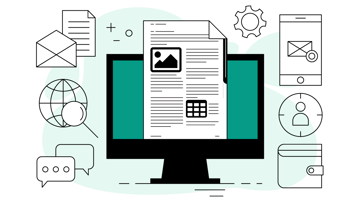What is a Tender Document?
If you're a business looking to secure a new project or contract, a tender document is what you'll use to prepare your competitive bid.
Think of it as the core of the entire procurement process. It provides every detail you need to know about a project, from the client's specific requirements to the submission requirements for your proposal. By outlining the scope of work, terms and conditions, and expected deliverables, the tender document ensures that all bidders are on the same page, creating a level playing field.
The Power of the Document: Why it's so Important
The importance of the tender document cannot be overstated. For buyers, it is a critical tool for due diligence, allowing them to:
- Clearly define their needs and set specific evaluation criteria.
- Objectively compare multiple proposals.
- Select the best fit based on factors like quality, experience, and price.
For suppliers, a well-crafted tender document is your roadmap to success, empowering you to:
- Identify project opportunities and risks.
- Create a precise and compelling proposal.
- Significantly increasing your chances of winning the contract.
Without a clear tender document, the entire bidding processes would be a chaotic guessing game, leading to disputes and delays.
Acquiring and Analyzing Your Bid Opportunity
Today, the most common way to acquire a tender document is through online portals. Whether it's a dedicated government site for the public sector or a private industry platform, these portals centralize the entire process. Once you've signed up, you can find the opportunity and download all the necessary documents, often including an Invitation to Tender (ITT) or a Request for Proposals (RFP).
Once you have the documents, a thorough analysis is paramount. You need to read between the lines and understand what the client truly values. Pay close attention to the tender requirements, and map them directly to your proposal. A well-organized table of contents will help you navigate the document and ensure you address every single point. It's a meticulous process, but it's what separates a good bid from a great one.
Mastering the Bid: A Checklist for Success
To truly maximize your chances, you must go beyond a simple read-through. A methodical analysis of the document reveals the client's priorities and potential deal-breakers. As you review, pay special attention to these crucial sections:
- Submission Requirements and Deadlines: This is non-negotiable. Missing a deadline or failing to submit a document in the specified format (submission requirements) can lead to immediate disqualification. Create a checklist to ensure you include every single annexure, form, and signed declaration.
- Evaluation Criteria: This is your roadmap to winning. Look for the percentage weighting or scoring rubric for different sections of the proposal. If a project is 60% based on technical expertise and only 40% on price, you know to focus your efforts on demonstrating your capabilities and experience rather than just offering the lowest bid. This section includes factors that show you how your competitive bid will be judged.
- Terms and Conditions: Don't just skim the legal jargon. This section outlines payment schedules, penalty clauses for delays, and dispute resolution processes. A clear understanding of these terms and conditions is vital to ensuring the project remains profitable and manageable for your business.
- Scope of Work: The scope of work provides the detailed specifications of what needs to be delivered. This is where you determine if you have the resources and expertise to complete the project successfully. A thorough review will help you identify any ambiguities and decide if the project is a good fit for your company.
Bidding Across Industries: From Startups to Enterprise
The nature of a tender document is a direct reflection of the project's complexity and the industry it serves. It's not a one-size-fits-all solution; rather, it adapts to the specific needs and conventions of different sectors.
- Small-Scale Public Sector Bids: The tender requirements for a local government's landscaping contract are typically concise, focusing on the essential scope of work, a clear timeline, and a basic financial breakdown. The tender submissions from small businesses or sole proprietors are likewise focused and to the point. The procurement process is often a matter of ticking boxes and meeting the minimum criteria, making it accessible even to startups looking to gain a foothold in the market.
- Large-Scale Enterprise Tenders: In the world of energy and major infrastructure, a tender from an enterprise company will be a highly complex, multi-volume dossier. This document includes detailed technical specifications, safety protocols, and a granular financial model. The evaluation criteria for such a project goes far beyond just price, as it includes factors that are like the bidder’s past experience, their technical expertise, and their financial stability. A single team member can't handle a project of this scale; it requires a coordinated effort from a diverse group of experts.
Winning with Technology: The Software Advantage
In today's fast-paced business environment, the traditional, manual approach to creating tender documents is becoming obsolete. This is where modern management software specifically designed for procurement process steps can give you a significant competitive bid advantage.
The Power of Automation and AI
These tools are a game-changer. They provide a foundational structure with automated templates that ensure a professional layout and consistent branding from the get-go. A team member can instantly generate a document with a pre-built table of contents and consistent numbering, saving valuable time. This efficiency allows you to focus on the content—the most critical part of your proposal. You can save and reuse successful content from past bids, creating a centralized, searchable content library. This not only speeds up the process but also process ensures consistency and quality.
AI-Powered Suggestions and Real-Time Collaboration
This is where the true innovation lies. Modern tender management systems are equipped with AI-powered suggestion engines connected directly to your content library. When a team member is writing a response, the AI can analyze the specific tender requirements and the context of the question, then automatically suggest relevant, pre-approved content from your past successes. This not only speeds up the tendering process dramatically but also ensures that the entire tender submissions is unified and reflects the collective expertise of your team. It allows multiple team members to work on the same document in real time, eliminating version control issues and ensuring a cohesive final product.
By embracing these technological advancements, you can streamline your entire process, reduce the risk of errors, and dramatically increase your efficiency, giving you a powerful edge in the market. As you continue to use the software, you build up your own knowledge base that becomes a foundation for contextual content suggestions, speeding up the proposal writing process at scale over time.
This approach allows you to work faster and faster, while ensuring your content meets the highest standards.








